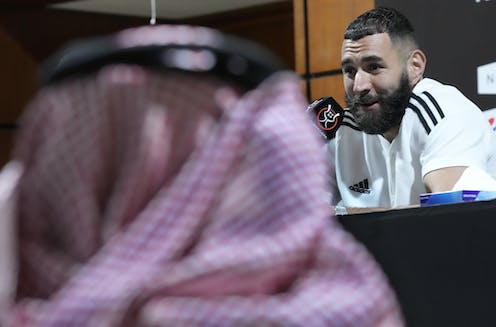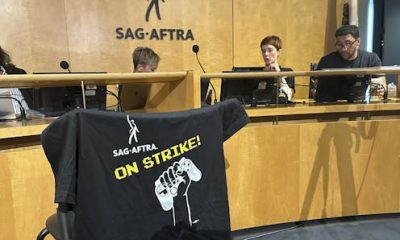
Karim Benzema — taking the money and running into the box. AP Photo/Hussein Malla
The announcements on consecutive days that the storied Real Madrid and France soccer star Karim Benzema is joining the Saudi Pro League and that Lionel Messi, thought by many to be soccer’s GOAT, will play next season in the United States’ Major League Soccer may mark the beginning of a new international bidding war for superannuated soccer stars.
MLS has for many years been recruiting aging talent from big European clubs, but the Saudi interest is new. Benzema’s move to Al-Ittihad – costing more than US$200 million – follows the acquisition of Cristiano Ronaldo by fellow Saudi club Al Nassr in 2022 for $100 million.
The Benzema announcement on June 6, 2023, furthered speculation that the kingdom is attempting to build a soccer league that will be competitive with Europe’s elite: the English Premier League, La Liga in Spain, Germany’s Bundesliga and Serie A in Italy.
Although it seems unlikely that the Saudi Pro League will make any dent in the popularity of those established European leagues any time soon, the trend of big-name signings may be the detriment of smaller leagues – chief among them MLS – which will struggle to compete with the power of the Saudi sporting purse.
A game of money and image laundering
Confirmation of the Benzema move came on the same day that LIV Golf, funded by the Saudi Public Investment Fund, announced its merger with the PGA – prompting comments about “sportswashing,” the use of investment in sports to launder the image of Saudi Arabia’s repressive, brutal and authoritarian regime.
However, there is one important difference between the Benzema story and LIV Golf. Saudi Arabians in particular – and the Arab peoples of the Middle East in general – have never shown much interest in golf. It was brought to the region by well-to-do British and American expats, and took hold only among local elites.
Golf Saudi was created in 2018 and launched an ambitious mass participation program as part of the kingdom’s Vision 2030 project, precisely because few Saudis played the game.
The same cannot be said of soccer. The game is beloved across the Arab world, and as soccer writer Simon Kuper and I wrote in “Soccernomics,” the nations of the Middle East would have produced competitive international teams long ago were it not for the region’s long-standing political instability. Some observers have described soccer as “the second religion of the Arab world.”
Oldies but goodies
The strategy of buying aging stars from European leagues to promote interest in an emerging soccer nation is a long-standing tradition.
In the 2016-17 season, China made waves when it started spending large sums in the transfer market to attract luminaries such as former Manchester United star Carlos Tevez and the Brazilian midfielder Oscar. The Australian A-League brought in players like Liverpool’s Robbie Fowler and Brazil’s Juninho in its early years, while Japan’s J.League launched in 1993 with aging World Cup legends Zico and Gary Lineker.
George Best dribbles past Pelé in the North American Soccer League.
AP Photo
But the greatest examples of this strategy come from the United States. Back in the 1970s, the North American Soccer League assembled what may be the greatest collection of international stars ever to play outside of Europe or South America. Pelé, Johann Cruyff, Franz Beckenbauer, George Best and Bobby Moore – sporting legends in their home countries – all played in the league. But it was not enough to save the NASL from collapse in 1984.
Its successor, MLS, launched in 1996 with the intention of avoiding some of the high spending associated with NASL. And in the early years, the league resisted the temptation of bringing in big European stars. But having almost folded in the early 2000s, the league changed course spectacularly with the signing of David Beckham for LA Galaxy in 2007 at the peak of the soccer star’s celebrity – if not soccer – power.
There followed a steady stream of aging international stars entering the league: Italian Alessandro Nesta in 2012, former Chelsea star Didier Drogba and Spain’s David Villa in 2015, English midfielders Steven Gerrard and Frank Lampard in 2016, and strikers Wayne Rooney and Zlatan Ibrahimovic in 2018.
David Beckham graduated from player to owner with the addition of the Inter Miami franchise in 2020, and there had long been rumors that he was working to secure the addition of Messi to the MLS roster. Messi’s agreement is a triumph both for Beckham and MLS, but it doesn’t remove the Saudis as a competitor in the long term and may push up the costs involved for all.
Will the Saudis pop the MLS bubble?
Since Beckham’s arrival as a player, MLS has flourished. In 2007 the league consisted of only 13 franchises, with the newly added Toronto FC paying a $10 million expansion fee to join. In May 2023, it was announced that San Diego would become the 30th MLS franchise, for a reported fee of $500 million. According to Forbes, the average value of an MLS franchise is currently $579 million.
This is remarkable, since for that price you could buy almost any soccer club in Europe outside of the top 20. Forbes also reckons that no fewer than seven of the 30 most valuable soccer clubs in the world are in MLS.
It’s also remarkable because the standard of play in MLS is not that high, compared with what is offered in Europe. Statistical research by me and others has shown that in soccer, you get what you pay for – to the point where the overall team payrolls generate reliable forecasts of long-term results.
The website Transfermarkt provides summary valuation of league squads, and currently values MLS players at $1.3 billion, compared with $11.3 billion for the English Premier League, $5.1 billion for La Liga, $4.9 billion for Serie A and $4.6 billion for the Bundesliga. The squad valuations for MLS are closer to those of the Belgian Jupiler League.
The valuation of MLS franchises is not based on the quality of the play, but on the prospects for growth if soccer becomes a mainstream spectator sport in the United States. MLS’s die-hard supporters are a forgiving lot but represent a tiny fraction of the U.S. sports market. Eventually, I believe MLS is going to have to field better players to continue its ascent – and that means competing in the international market.
Messi heading for David Beckham’s Inter Miami.
AP Photo/Francois Mori
The worry for MLS is that it now has a new competitor for the best aging players: Saudi Arabia. MLS wanted Ronaldo and it wanted Benzema too. Inter Miami and MLS have Messi, but they had to overcome competition from Saudi team Al Hilal.
The Messi move is a great coup for MLS. But the emergence of the Saudis as competitors suggests that future opportunities will be diminished, and that the league will have to pay more for the stars it can attract.
Stefan Szymanski does not work for, consult, own shares in or receive funding from any company or organization that would benefit from this article, and has disclosed no relevant affiliations beyond their academic appointment.
Advertisement

Advertisement
Contact Us
If you would like to place dofollow backlinks in our website or paid content reach out to info@qhubonews.com











